GCSE Maths Paper 2 2023: Summary Of Topics, Questions & Planning For Paper 3
Christine Norledge, our regular contributor and maths expert, is back to give a detailed analysis of the GCSE Maths Paper 2. Analysing the questions and topics that have appeared on Paper 1 and 2, Christine identifies which topics are most likely to appear on the final paper for 2023. Read on to find out which topics make her hit-list to revise next.
Originally published 9th June 2023
We’re now two papers down in this year’s maths GCSE exams and with Paper 3 just around the corner next Wednesday (14th June), the finish line is in sight.
We’re back again with an analysis of Paper 2 and to update our topic hit-lists for your revision ahead of Paper 3. As we have now had two exam papers, we can really start to narrow down the list of which topics are most and least likely to appear on the final paper.
However, please bear in mind that any topic can come up on any paper – and just because something has appeared on one of the first two papers, this doesn’t mean that it won’t come up again on Paper 3! However, these insights can help you focus and direct your students’ revision when time is tight…
Please note, this blog focuses on the Edexcel papers, rather than AQA, OCR or IGCSE. It’s also specifically about GCSE mathematics, rather than any A-Level exams.
The recommendations and analysis that follow are my own interpretation of GCSE Maths Paper 2, and are not endorsed in any way by Edexcel. The question papers and mark schemes are yet to be formally released.
GCSE MATHS 2026: STAY UP TO DATE
Join our email list to stay up to date with the latest news, revision lists and resources for GCSE maths 2026. We’re analysing each paper during the course of the 2026 GCSEs in order to identify the key topic areas to focus on for your revision.
GCSE dates 2026
GCSE results (2026 when available)
Get ahead on revision with the GCSE maths papers analysis from 2025:
Analysis of GCSE Maths Paper 1 2025
Analysis of GCSE Maths Paper 2 2025
GCSE Maths Paper Analysis and Summary 2025
GCSE Maths Teacher Survey Results 2025
- Hit list of revision recommendations for Edexcel Paper 3
- How did students react to Maths Paper 2?
- What was the process behind this Maths Paper 2 analysis?
- Detailed analysis of Paper 2 Foundation
- Detailed analysis of Maths Paper 2 Higher 2023
- Preparing for Paper 3: Our detailed topic analysis
- What’s next for GCSE Maths 2023?
- Addendum: Links to the free maths revision guides for all topics in the hit lists above
Hit list of revision recommendations for Edexcel Paper 3
Let’s kick off with the all important updated hit list of recommended revision priorities for Edexcel Paper 3 – we’ll then move on to the analysis of Paper 2.
Below are the lists of topics (Foundation and Higher) that we’d direct students towards. This should be viewed as a suggested, incomplete list, not an exclusive prediction of the final paper. As usual, it should be noted that any topics could be assessed on any paper, including reassessment of topics that have already appeared on the first two papers.
These lists are an updated version of the ones in our blog on GCSE Maths 2023 Paper 1, with a couple of additions and tweaks based on content appearances over the series so far.
Foundation revision focus list

Higher revision focus list

For further detail and other suggested topics, please see the more detailed tables and analysis that follows.
How best to share these revision recommendations
There’s a risk that students may ‘over-interpret’ this list if it’s shared in the above format. Another way to share this information with students is to create collections of practice exam questions that target this topic hit-list using the Third Space Learning secondary maths resources library.
To make it easier for you, we’ve already put together a free bundle that includes worksheets on the hit list topics. Each worksheet includes functional and applied reasoning questions, practice questions and exam style questions.
At the end of this blog you’ll also find links to the specific GCSE maths revision resources, questions and worksheets you’ll need for each of the hit-list topics, which may be useful in producing revision resources along these lines for your students.
Now, let’s turn to our analysis of Paper 2…
Paper 3 Revision: GCSE Exam Questions and Worksheets
Based on the Edexcel GCSE Maths Exam 2023 Paper 1 & 2, this resource provides all of the worksheets that accompany our revision guides and correspond to the recommended revision priorities for Edexcel Paper 3.
Download Free Now!How did students react to Maths Paper 2?
Student reactions to Paper 1 were generally fairly positive, and this seems to have continued for Paper 2. As usual, candidates shared a few thoughts on their stand-out questions on social media, such as this pithy summary of the context-based problems on the Foundation paper:

The crossover question about house prices drew some criticism from would-be estate agents:


Some candidates commented that the first half of the Higher paper was much easier than the second:

And the final question inevitably caused a bit of fuss:
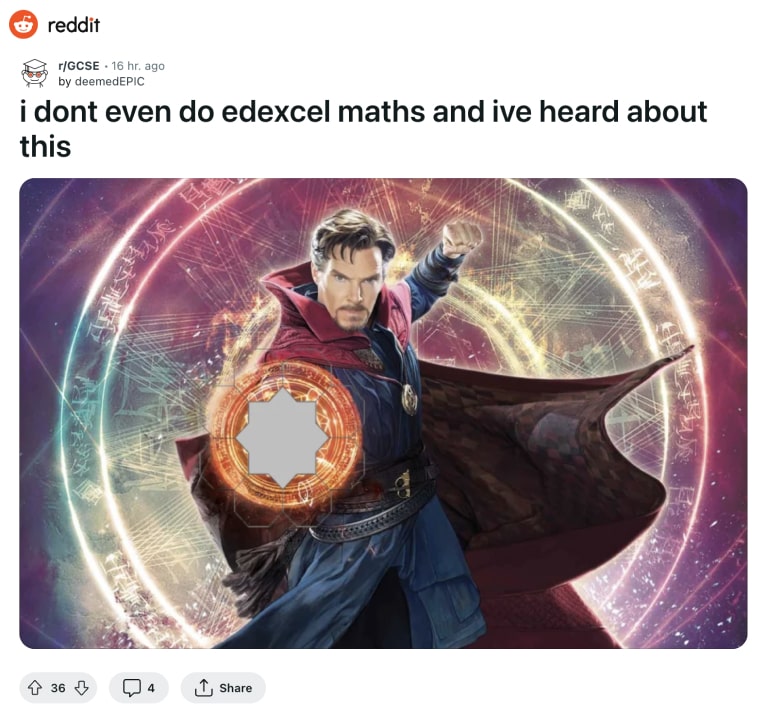
Now let’s have a look at the papers in question in more detail.
What was the process behind this Maths Paper 2 analysis?
In this blog, I’ve used the same processes and classifications as in my previous exam analysis blog posts:
- Question Level Analysis Of Edexcel Maths Past Papers (Foundation) (2017-2019)
- Question Level Analysis Of Edexcel GCSE Maths Higher Past Papers (2017-2019)
And 2022’s series of exam paper analysis blogs:
You can read in more detail about the processes used in the GCSE Maths Paper 1 2023 blog.
The suggestions in this blog are based on data analysis of four series of June papers that were actually sat by students, i.e. June 2017-2019 and 2022 exam papers.
These are only ever going to be informed recommendations from me so we leave it, of course, to your professional judgement to decide on what to do with the information.

Unlimited GCSE maths tutoring with Skye, the voice-based AI maths tutor.
Built on the same principles, pedagogy and curriculum as our traditional tutoring but with more flexibility, reach and lower cost.
Help your GCSE students achieve their target grade with Skye’s one to one maths tutoring.
Watch Skye in actionDetailed analysis of Paper 2 Foundation
Foundation Paper 2 followed a similar pattern to Paper 1 in terms of accessibility, and it felt like a fair paper for a cohort who have had disruption to their learning time as a result of the 2020 pandemic.
Like Paper 1, the paper ramped slowly at the start, with a surprising number of procedural one-markers. For example, it’s not unusual to see a 3-mark problem-solving question within the first ten questions, but there was nothing much like this until well into halfway through the paper.
Maths Paper 2 2023 was a fair, accessible paper

Most of the pre-crossover content was very straightforward (the box-packing question and the cinema seats stand out as ones that candidates may have struggled with). Quite a lot of the context-based work seemed to appear in the crossover content, meaning that it was set in a fairly accessible way.
Paper 2 was a similar level of difficulty to previous years
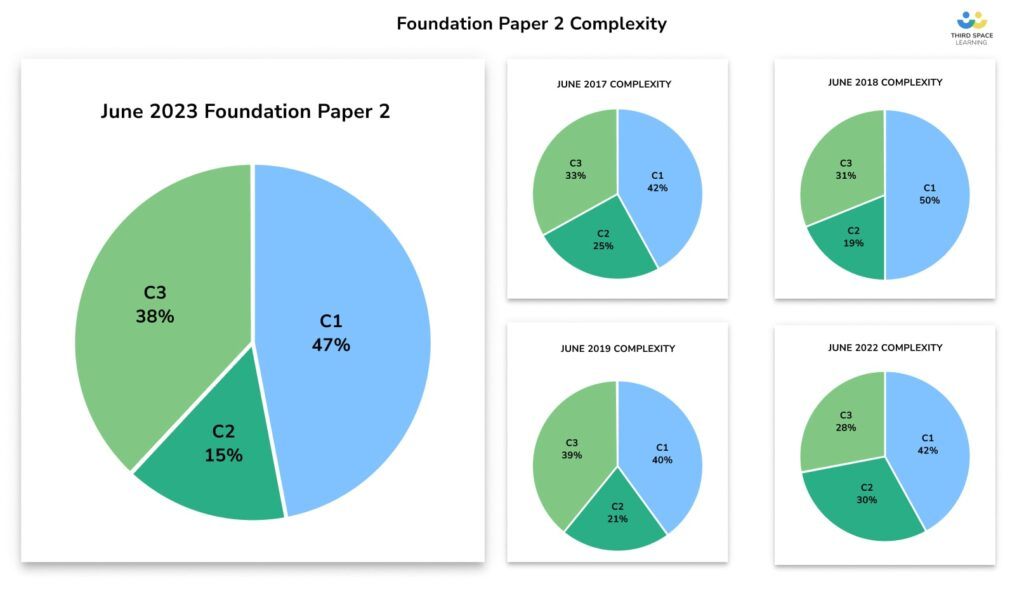
Although there were slightly fewer C1 marks on Paper 2 than Paper 1 (approx 60% vs 47%), the paper still felt of a similar level of difficulty, possibly because quite a few of these C1 marks were in the crossover content.
C2 content appears slightly down on this paper. In particular, students weren’t really asked to identify errors or comment on someone’s working out – there was one mark available for this in the crossover content. With the expectation of more work on charts and graphs on Paper 3, it’s likely we’ll also see more questions requiring students to write explanations or identify errors.
Number and proportion dominated leaving some clear gaps for Foundation Paper 3
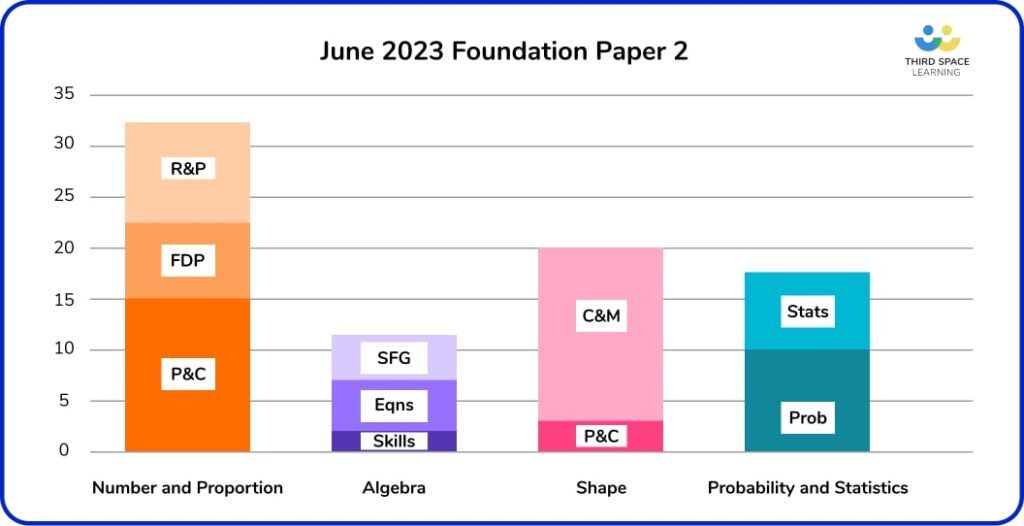
In comparison with previous series, we’ve got quite a bit more Number and Proportion work on 2023’s Foundation Paper 2. This was to be expected to an extent, as the Proportion strand was relatively low on Paper 1.
Looking at Algebra, we’re quite a bit lower than previous Paper 2s, and down overall on the series so far. This means that we can probably expect Algebra topics to be hit harder on Paper 3, especially in the Algebra Skills area where we still have quite a few gaps. We had 10 marks on linear equations and inequalities in the crossover content, so any further work on equations is likely to be more straightforward.
Also of note for Paper 3 is the limited work on Shape Properties and Constructions. It’s likely therefore that angle facts will crop up again on Paper 3. There was also a slight skew towards Probability over Statistics.
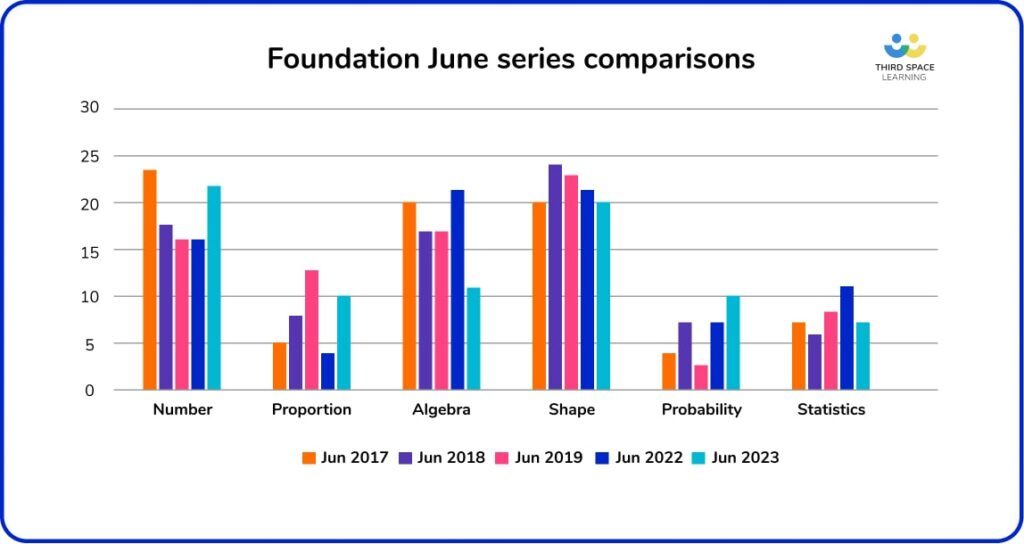
Detailed analysis of Maths Paper 2 Higher 2023
Despite the “scandalous” final question, Paper 2 2023 Higher was a fair and accessible paper

The crossover content felt, if anything, more straightforward than Paper 1, with the area comparison question seeming like the only real sticking point. But while this type of question tends to tax most Foundation students, Higher candidates should have the algebra skills to be able to tackle questions like this confidently.
The middle third to half of the paper had some mid-range topics asked in straightforward procedural ways, for example, drawing a cumulative frequency graph and estimating the median, completing a histogram, solving a pair of linear simultaneous equations (non-context), and nth term of a quadratic.
Topic combinations towards the end of the paper add challenge, but these also feel as fair as, if not more generous than, previous series. The bounds in context problem is applied to a standard right angle trigonometry question, where historically candidates have been given an unfamiliar context or real-life scenario. Similarly, the final question which caused the most contention is more a test of mathematical reasoning ability, and perhaps mathematical flair, as the procedural skills involved are of a relatively low level.
Like Paper 1, complexity was relatively lower compared to previous years

After the relatively low complexity of 2023’s Paper 1, it’s surprising to see another Higher paper with a high proportion of standard procedural (C1) questions, but we did see a lot of straightforward questions in the middle of the paper, such as cumulative frequency, histogram, simultaneous equations, etc.
Again, roughly 20% of the marks were C2 on questions involving reasoning, interpreting charts or tables, reading and synthesising information. On 2023’s Higher Paper 2, these were mostly “show that” geometrical reasoning questions.
Similarly to Paper 1, this Paper 2 has the lowest proportion of C3 questions of all the summer series so far. It will be interesting to see if the complexity is ramped up for the final paper of the series.
Paper 2 heavier on number but much lighter on proportion

Higher Paper 2 2023 was heavier on Number topics than previous Paper 2s, due to quite a bit of work on errors and bounds in context, a compound interest comparison, and a few accessible marks in the crossover content for calculator use and product of primes.
As predicted in our Paper 1 2023 blog, we did see more ratio on this paper, hitting most key ratio skills at Higher, including combinations with algebra, fraction links, in a context-based problem and finally used in the vectors question.
However, there has still been very limited work on Proportion (we have had one simple equation of proportionality on Paper 1), so this is still one to watch for Paper 3, potentially as inverse proportion.
The amount of algebra work was lower than previous June series, but not significantly. We had lots on equations and inequalities, with 10 of these marks in the crossover content. Then, we had a straightforward pair of simultaneous equations and solving via iteration later on in the paper.
This paper was very heavy on geometrical reasoning, with a large skew towards using this in calculations or measurements – area was hit fairly hard in this paper, and we also saw:
- embedded Pythagoras;
- right-angled trigonometry in combination with bounds;
- use of the sine rule.
Some candidates may have conceivably used ½ ab sin C to solve the problem about areas in similar triangles (although this was only one possible path to a solution, and arguably not the easiest).
In Statistics, we had two standard questions on cumulative frequency graphs and histograms, but very little requiring calculation of averages, so this might be worth watching out for on Paper 3.
The Probability work on this paper was quite wordy, and some candidates may have struggled to access these as a result. However, the maths involved in these questions was fairly straightforward.

Preparing for Paper 3: Our detailed topic analysis
Edexcel’s Paper 2 and Paper 3 are both Calculator papers, and also functionally identical – there is no difference between what can appear on either paper. As we’ve now had one Calculator paper, we can return to the data analysis lists and start to pinpoint what other topics may come up.
The rest of this article looks across the past 4 years’ data we have on both Foundation and Higher summer papers to highlight in more detail how topics and questions have fallen across Papers 1, 2 and 3 and – importantly – what you might expect to see on the final paper in 2023.
Each section and chart is an attempt to answer a key question that will inform the next stage of your GCSE revision.
Question: Which topics from the Calculator paper hit lists appeared on Paper 2? Which might feature on Paper 3?
For Paper 3 prep, we’ve reviewed the Calculator paper topic hit-list from our GCSE Maths Paper 1 blog. We’ve divided those calculator topics into those which appeared on Paper 2 and those which have not yet appeared.
As these topic lists are now quite narrow, we wouldn’t recommend sharing these with students in this form. It is likely that we’ll see reassessment of other topics alongside these.
The other thing to note is that some topics are now less likely to come up as other related topics have been assessed in depth. For example, we’ve seen frequency polygons, cumulative frequency, histograms and scatter graphs on Higher Papers 1 and 2, so we may not end up seeing box plots on Paper 3 after all.
Updates to the Calculator Paper 2023 hit-lists (Foundation & Higher)


Question: Which topics might come up again?
Any topic can theoretically be assessed on any paper(s) in the series. However, there are a few topics that have historically come up on more than one paper. Many of these are fundamental ideas or processes, so most shouldn’t come as a surprise, but it’s worth bearing in mind when directing students’ revision.
Frequently occurring Calculator paper topics (Foundation)
Due to the smaller amount of content coverage, topics are more likely to be reassessed on Foundation papers than Higher papers. Here are a few to look out for:

Frequently occurring Calculator paper topics (Higher)
Due to the wider range and depth of topics on Higher GCSE, topics are less likely to be repeated at Higher tier – this is evidenced in the data analysis of topic frequencies on multiple papers.
This table contains a few exceptions, along with notes on how this applies to the 2023 series so far. Quite a few of these repeat topics have already been repeated, but there are still a couple to look out for.

Question: Which Calculator topics haven’t been seen for a while?
This is a selection of topics that have only appeared once on the Calculator papers between 2017 and 2019, and did not appear in the 2022 series. These may be ones to watch out for as they are less frequently assessed, but perhaps due a turn this year!
Some of these are quite niche topics, so it’s a good idea to focus on once students are confident with the essentials for each tier. Topics such as invariance aren’t usually worth many marks and are often forgotten but these might be worth a quick understanding check with Higher students who are aiming for grades 8-9 as they’ll need every mark they can get.
4 topics missing from recent Foundation Papers 2 and 3
Three of the topics originally on this list (representing linear inequalities, solving linear inequalities and conversion graphs) came up on Foundation Paper 2 – the remaining topics are yet to appear in 2023.

11 topics missing from recent Higher Papers 2 and 3
It is of note that this list is identical to the one published in my Paper 1 blog – i.e. we haven’t seen any of these topics on Higher Paper 2.
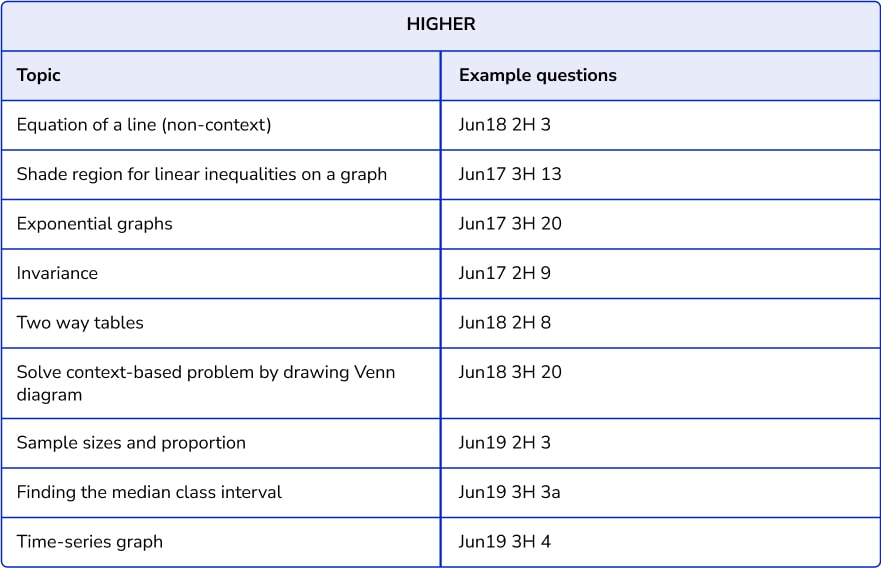
Question: Can we identify any “bigger picture” gaps?
In this section, we compare the strand distributions for Papers 1 and 2 2023 to the previous four summer series. We can see that some 2023 strands are significantly lower than the average picture so we might expect to see these topics hit harder on Paper 3.
At Foundation, the biggest gaps are in Algebra & Shape

At Foundation level, the biggest gaps appear in Algebra and Shape, so we can probably expect proportionally more of these strands on Paper 3. Statistics content is still a little light, but there was relatively little of this on Paper 2, so we can expect more on Paper 3.
Drilling down into the detail, we have significant gaps in:
- Place value and standard form calculations
- Laws of indices, expanding brackets
- Graphs, particularly linear and quadratic graphs
- Any work on functions, including function notation and function machines
- Pythagoras and trigonometry in right angled triangles
- Working with measurements or units in context (apart from time)
- Shape and angle properties, particularly reasoning using angles
- Constructions, loci and 3D shape representation (these don’t appear very frequently)
- Presenting data, especially simple charts (bar charts, pictograms, pie charts)
- Mutually exclusive events, relative frequency, listing outcomes
At Higher, the biggest gaps are Algebra, Shape & Statistics

Proportionally we’re down on Algebra, Shape and Statistics, so we’re likely to see more of that content on Paper 3.
Drilling down into the detail, we have significant gaps in:
- Standard form calculations
- Proportion calculations
- Manipulating quadratic expressions (although this has appeared embedded)
- Graphs, particularly non-linear graphs
- Constructions, loci and 3D shape representation (these don’t appear very frequently)
- Processing data (i.e. averages and range calculations)
- Data collection and sampling – capture-recapture appeared last year but could come up again
What’s next for GCSE Maths 2023?
That concludes our analysis so far on the two first maths papers. The final GCSE maths paper is on Wednesday 14th June. We’ll be back then with a quick review of Paper 3.
In late June, look out for a more in-depth analysis of the 2023 series of papers as a whole. We’ll consider how you can use this year’s exam questions with next year’s cohort and do the data-crunching to look at how the 2023 papers sit in the wider context of previous Edexcel exam papers.
Addendum: Links to the free maths revision guides for all topics in the hit lists above
Foundation tier revision guides
Higher tier revision guides
DO YOU HAVE STUDENTS WHO NEED MORE SUPPORT IN MATHS?
Skye – our AI maths tutor built by teachers – gives students personalised one-to-one lessons that address learning gaps and build confidence.
Since 2013 we’ve taught over 2 million hours of maths lessons to more than 170,000 students to help them become fluent, able mathematicians.
Explore our AI maths tutoring or find out how our GCSE maths tutoring programmes could support students in your school.







